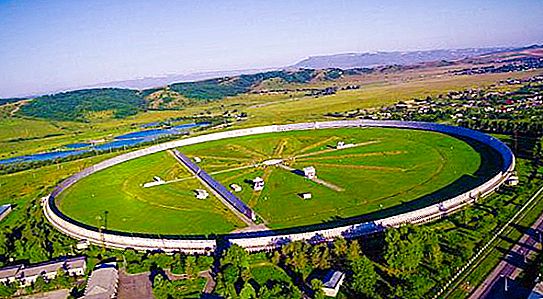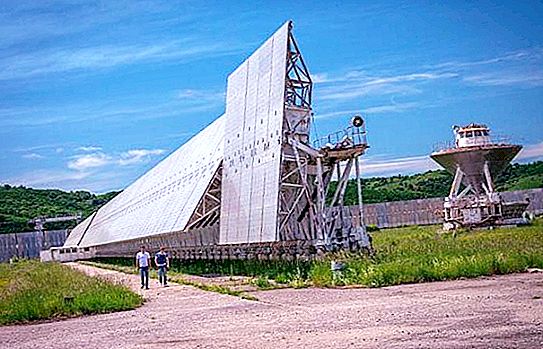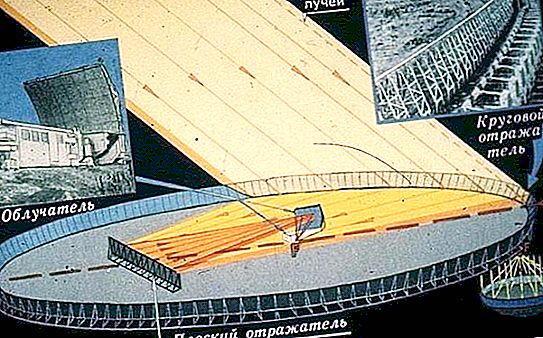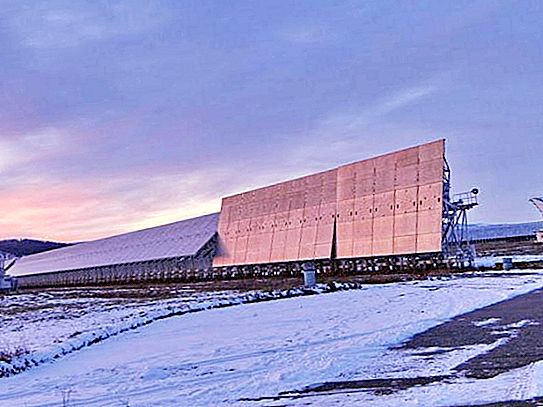RATAN-600 is the largest radio telescope in the world located in Karachay-Cherkessia. The main mirror has a diameter of 576 meters, and the geometric area of the antennas is 15, 000 m 2. The telescope is designed to study planets, the Sun, galaxies, extragalactic objects, spectral radiations and other purposes.

History: RATAN-600
The idea of building a domestic radio telescope based on the work of S. E. Khaikin and N. L. Kaydanovsky vital since the 50s. The experimental Pulkovo telescope was originally created, on the basis of which the effectiveness of variable-profile antennas for space research was proved.
It was a time of the Cold War, when the rivalry between the USA and the USSR was heated up to the limit. The leadership, inspired by the launch of the first satellite, demanded (to the delight of scientists) to consolidate their success by building grandiose objects for space exploration. They became the unique six-meter BTA azimuthal mirror telescope and the RATAN-600 radio telescope. The project was finally approved on August 18, 1965.
By the summer of 1974, the northern sector of the reflector and irradiator No. 1 were commissioned. The first PKS 0521-36 radio source was investigated on July 12, 1974. By the beginning of 1977, the remaining parts of the complex were introduced: a flat reflector, the southern, eastern and western sectors.
Description
The RATAN-600 telescope is operated by the Special Astrophysical Observatory of the Russian Academy of Sciences (SAO) - the only world-class observatory in the Russian Federation. The facility is equipped with a 576-meter ring antenna (circular reflector), consisting of 895 elements. The size of each receiving element is 2 m wide and 11.4 m high.
Of the total area of the facility of 15, 000 m 2, the antenna itself (the outer part) occupies only 3, 500 m 2. The inner part is an open space where emitters, a variety of devices that receive and analyze cosmic radiation are located.
The RATAN-600, whose photo is impressive, is installed on the southern outskirts of Zelenchukskaya stanitsa (Karachaevo-Cherkessia). The village of the observatory, including laboratory buildings, residential buildings, a school, is located on the banks of the Bolshoy Zelenchuk River near the Lower Arkhyz fortification of the 9th-13th centuries.
Specifications
The RATAN-600 device uses the new principles of telescope engineering: altazimuthal mount, aperture synthesis and controlled surface. Main characteristics:
- Frequency range: 610-30000 MHz.
- Wave range: 1-50 cm.
- Accuracy: 1-10 arc seconds.
- Maximum angular resolution: 2 angles. sec
- Limit of determination of brightness temperature: 0.050 mK.
- Limit of determination of flux density: 0.500 mJ.
Thanks to a team of researchers creating and constantly improving these devices, the complex remains a key element in observing space.
Reception cabins
In addition to a circular reflector collecting and concentrating information (radiation), RATAN is equipped with five receiving cabins. They contain recording devices.
Cabs are placed on railway platforms, which allows you to move them along 12 radial tracks. Mobility provides research objects at different azimuths in increments of 30 °.
Scientific work
A wide program of various studies is being implemented in the CAO, including:
- A comprehensive study of solar activity in the radio range.
- Astrometry with extreme angular resolution (speckle interferometry) of binary and multiple stars and individual stars with extended atmospheres.
- High resolution spectroscopy of atmospheres and winds of stars of various types (in particular, the complex has become the main supplier of measurements of magnetic fields of stars).
- Radio and optical spectroscopy of nebulae in our and other galaxies.
- Photometry with the ultimate time resolution of relativistic objects (pulsars, black holes and others).
- Photometry and spectroscopy of moderate and low resolution microquasars, gravitational lenses, normal and peculiar galaxies and individual stars in them.
- Construction of a spatial and kinematic picture of a local group of galaxies.
- Photometry and spectroscopy of the optical components of gamma-ray bursts at cosmological distances.
- Radio mapping of the relict background of the Universe.
RATAN-600 (Zelenchuk) has the status of open collective use tools. Along with domestic astronomers, a significant part of the observational time is allocated to foreign colleagues, as a rule, for the implementation of joint projects.
Modernization
Over the years of the existence of the CAO, a unique team of instrument astronomers has been formed in it. Over the past decade, experts have re-equipped the telescope with radiation receivers with high and constantly increasing characteristics: sensitivity, spectral, spatial and temporal resolution.
In particular, the drive equipment of the secondary irradiators RATAN-600 was re-equipped and a system of automated control of the positioning of irradiators was introduced. Since 2008, a new version of the high-resolution solar spectral-polarization complex (SPKVR-2) has been operating.
An Internet resource has been developed to present data from solar observations, which collects and analyzes data in real time. It has services for searching and analyzing data, including comparison with data from other instruments, obtaining spectra and other parameters of local sources.
Work continues on the use of primary irradiators with a single phase center, which allows to “unload” the primary focus and conduct observations in the multi-frequency tracking mode (the “Octave” project for irradiators No. 1 and No. 3).
Work is underway to monitor and study external interference in the decimeter range with subsequent refinement of the receiving paths to protect against electromagnetic interference radiometers of this range.
Prospective research
CAO oversees research programs designed to shed light on the mysteries of the universe. Among the main projects:
- Sun research.
- The structure and kinematics of interstellar gas in the regions of star formation.
- Activity of extragalactic radio emission sources.
- Search for relativistic jets in active galaxies and quasars.
- Study of the structure and kinematics of interstellar gas in star formation regions.
- Studies of the spectra of extragalactic proto-objects.
- Cosmological gene.
- Observations on the MARS-3 Matrix Radio Engineering System.
- Multiwave observations of the LSI + 61 303 object.
- Study of the spectra and variability of GPS sources.
- Simultaneous spectra of lacertids.
- Monitoring of microquasars.









